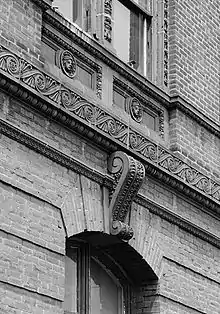
Vitruvian scroll pattern

Detail of a building showing the Vitruvian scroll pattern rendered in terra cotta
The Vitruvian scroll is a scroll pattern used in architectural moldings and borders in other media. It is also known as the Vitruvian wave, wave scroll, or running dog pattern.[1] The pattern resembles waves in water or a series of parchment scrolls viewed on end.
"Vitruvian" refers to the Roman architect Marcus Vitruvius Pollio ("Vitruvius"), who wrote the oldest extant book on architecture,[2] which describes some of the classical architectural orders.
See also
References
- ↑ "Running-dog pattern". Encyclopædia Britannica. Britannica. 2013. Retrieved March 15, 2013.
- ↑ Vitruvius, "The Ten Books on Architecture"
External links
This article is issued from Wikipedia. The text is licensed under Creative Commons - Attribution - Sharealike. Additional terms may apply for the media files.